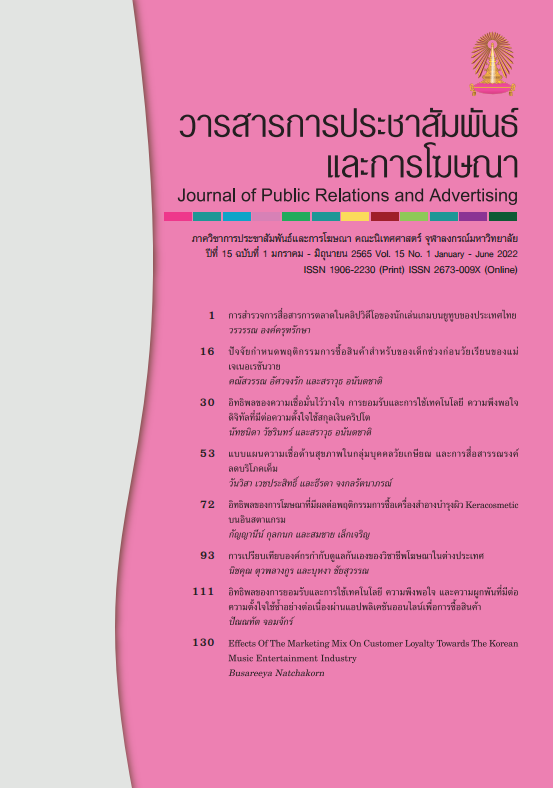A Comparison of the Self-Regulatory Organizations in Successful Countries
Main Article Content
Abstract
This research aimed to study the structure and operation of advertising self-regulatory organizations in successful countries The qualitative research methodology was conducted, as well as utilized document analysis method to collect data from those are public records from Self-Regulatory Organizations (SROs) in UK, Australia, and China. The following were the research findings 1) UK and Australia has protected freedom of expression under the Constitution. As for China, has been organized the new world media. 2) The self-regulatory driving process in the UK and Australia has developed ethical standards, establish a supervisory committee, and corporate communication. Chinese organizations have established self-regulating associations, research studies, and elevate the industry. 3) UK and Australia are responsible for infrastructure, law, enforcement, consumer protection, advocacy, and governance, while Chinese organizations have more comprehensive roles to play. 4) All organizations have a similar management team. And committees according to the scope of work of each organization. 5) Australian and Chinese organizations aim for the best benefits of both society and commerce. But in the UK, the goal is to make advertisements socially responsible. 6) Government organizations' strategy focuses on infrastructure, convenience, and safety. Self-regulatory organizations have strategies for building acceptance and participation, complaint handling, and corporate management. And 7) Organizations in the UK and Australia have funded sources from levy, fees, and fines. In China, funds come from other sources, such as membership fees, donations, and government grants.
Article Details
References
กวี อิศริวรรณ. (2530). ความคิดทางการเมือง. กรุงเทพฯ: บริษัทสยามบรรณ.
กัลยกร วรกุลลัฎฐานีย์ และ พรทิพย์ สัมปัตตะวนิช. (2553). การโฆษณาเบื้องต้น. กรุงเทพฯ: สำนักพิมพ์มหาวิทยาลัยธรรมศาสตร์.
กาญจนา แก้วเทพ. (2556). สื่อสารมวลชน ทฤษฎีและแนวทางการศึกษา. กรุงเทพฯ: ภาพพิมพ์.
เดชพันธุ์ ประวิชัย. (2558). การโฆษณากับสังคม: Advertising in contemporary society. ปทุมธานี: สำนักพิมพ์มหาวิทยาลัยกรุงเทพ.
ทศพล สมพงษ์. (2556). พัฒนาการและการพัฒนาประชาสังคม. กรุงเทพฯ: สำนักงานสภาพัฒนาการเมือง สถาบันพระปกเกล้า.
นิวัต วงศ์พรหมปรีดา. รองนายกสมาคมโฆษณาแห่งประเทศไทย ฝ่ายมาตรฐานวิชาชีพ. (4 ตุลาคม 2561). สัมภาษณ์.
บุหงา ชัยสุวรรณ. (2561). การกำกับดูแลโฆษณา: หลักการ แนวปฏิบัติ และกรณีศึกษา. กรุงเทพฯ: สำนักพิมพ์ดีฉัน เฮาส์ แอดเวอร์ไทซิ่ง.
ปรมะ สตะเวทิน. (2538). การสื่อสารมวลชน: กระบวนการและทฤษฎี. กรุงเทพฯ ห้างหุ้นส่วนจำกัดภาพพิมพ์.
พจนา สัจจาศิลป์. (2548). การโฆษณากับสังคม: Advertising in contemporary society. กรุงเทพฯ: แผนกตำราและคำสอน มหาวิทยาลัยกรุงเทพ.
พนา ทองมีอาคม. (2546). การควบคุมโฆษณา มุมมองหนึ่งของนักวิชาการ. โรงแรมบางกอกเซ็นเตอร์, กรุงเทพฯ.
พระราชบัญญัติการประกอบกิจการกระจายเสียงและกิจการโทรทัศน์ พ.ศ. 2551, (2551).
รดี ธนารักษ์. (2556). การศึกษาและข้อเสนอแนะเกี่ยวกับแนวทางและกลไกการกำกับดูแลที่เหมาะสมสำหรับประเทศไทย (รายงานผลการวิจัย). อุตรดิตถ์: มหาวิทยาลัยราชภัฏอุตรดิตถ์.
วิทยากร เชียงกูล. (2551). ปรัชญาการเมือง เศรษฐกิจ สังคม. กรุงเทพฯ: สายธาร.
ศรัญญ์ทิตา ชนะชัยภูวพัฒน์ และ บุหงา ชัยสุวรรณ. (2559). ทิศทางการพัฒนาระบบกำกับดูแลการโฆษณาในสังคมไทย. วารสารนิเทศศาสตร์ธุรกิจบัณฑิตย์, 10(1), 117-146.
สมควร กวียะ. (2545). การสื่อสารมวลชน: บทบาทหน้าที่ สิทธิ เสรีภาพ ความรับผิดชอบ. กรุงเทพฯ: อักษราพิพัฒน์.
สมาคมโฆษณาแห่งประเทศไทย. (ตุลาคม 2563). สรุปการกำกับดูแลตนเองของวิชาชีพโฆษณาในประเทศไทย. เอกสารนำเสนอในที่ประชุมเสวนาเวทีข้อเสนอเชิงนโยบายการกากับดูแลตนเองของวิชาชีพโฆษณา และการผลิตสื่อโฆษณาที่ตระหนักถึงจรรยาบรรณวิชาชีพ, กรุงเทพฯ.
สำนักงานเลขาธิการสภาผู้แทนราษฎร. (2558). วาระปฏิรูปที่ 32 การกำกับดูแลสื่อ วาระปฏิรูปที่ 33 สิทธิเสรีภาพสื่อบนความรับผิดชอบ วาระที่ 34 การป้องกันการแทรกแซงสื่อ. กรุงเทพฯ: สำนักการพิมพ์ สำนักงานเลขาธิการสภาผู้แทนราษฎร.
อัศวิน เนตรโพธิ์แก้ว. (2561). สื่อศาสตร์ Mediumology หลักการ แนวคิด นวัตกรรม. กรุงเทพฯ: สำนักพิมพ์นาคร.
ThaiPublica. (2557a). แนวทางการกำกับดูแลตนเองให้มีประสิทธิภาพตามกรอบมาตรฐานจริยธรรม จรรยาบรรณ และความรับผิดชอบ. วันที่เข้าถึงข้อมูล 16 มีนาคม 2563 แหล่งที่มา https://thaipublica.org/ wp-content/
uploads/2014/04/2++กระบวนการในการกำกับดูแลตนเองและจรรยาบรรณ.pdf
ThaiPublica. (2557b). กสทช. เสนอคู่มือจริยธรรมและการกำกับดูแลกันเอง แจงแผนปฏิบัติผู้ประกอบกิจการกรณีภัยพิบัติหรือเหตุฉุกเฉิน. วันที่เข้าถึงข้อมูล 16 มีนาคม 2563 แหล่งที่มา https://thaipublica.org/2014/04/ethical-guideline-and-self-regulation-for-broadcasting/
ACMA. (2020). ACMA corporate plan 2020-2021. Retrieved March 24, 2020 from https://www.acma.gov.au/ sites/default/files/2020-08/ACMA%20Corporate%20plan%202020-21.pdf
Ad Standard. (2018a). Ad Standards. Retrieved March 16, 2020 from https://adstandards.com.au/about/ad-standards
Ad Standards. (2018b). Strategic plan. Retrieved March 16, 2020 from https://adstandards.com.au/about/ strategic-plan
Bartle, I., & Vass, P. (2005). Self-Regulation and the Regulatory State: A Survey of Policy and Practice (17). Retrieved March 16, 2020 from http://www.bath.ac.uk/management/cri/pubpdf/Research_Reports/17_Bartle_Vass.pdf
Bovee, C. L. (1995). Advertising excellence. New York: McGraw-Hill.
Campbell, A. J. (1999). Self-Regulation and the media. Federal Communications Law Journal, 51(3), 711-772.
Dacko, S. G., & Hart, M. (2005). Critically examining theory and practice: Implications for coregulation and coregulating broadcast advertising in the United Kingdom. The International Journal on Media Management, 7(1-2), 2-15.
Gray, O. (2012, November 7-8). Principles and Governance of Self-Regulation. Paper presented at the Advertising Standards-Principles and Practice Dialogue, Hanoi, Vietnam.
Harker, D. (2003). Towards effectiveness advertising self-regulation in Australia: the seven components. Journal of Marketing Communications, 9, 93-111.
Hobbes, T. (1839). Opera philosophical quae Latina scrip sit Omni. London: Londini.
ICC, (2018). ICC’s Advertising and Marketing Communication Code. Retrieved February 14, 2019 from https://iccwbo.org/publication/icc-advertising-and-marketing-communications-code/Kleinsteuber, H. J. (2004). The interest between regulation and governance: Guaranteeing media freedom on the internet. Amsterdam: Organization for Security and Co-operation in Europe.
Lane, W. R., King, K. W., Russell, J. T., & Kleppner, O. (2005). Kleppner's advertising procedure. Upper Saddle River, N.J.: Pearson/Prentice-Hall.
Livingstone, S. (2012). Critical reflections on the benefits of ICT in education. Oxford Review of Education, 38(1), 58-67.
Locke, J. (1823). Two treatises of government. London: Thomas Tegg.
McQuail, D. (1994). Mass communication theory (3rd ed.). Cambridge: Sage.
Office of Communication. (2018). What is Ofcom? Retrieved March 16, 2020 from https://www.ofcom.org.uk/about-ofcom/what-is-ofcom
Paizer, C., & Scheuer, A. (2014). Self-regulation, co-regulation, public regulation. Retrieved from http://emrsb.de/news/Paizer_Scheuer_Uneseco-Clearinghouse_Yearbook
Rousseau, J. J. (1896). Du contract social. London: Longmans.
Spence, E. H., & Heekeren, B. V. (2005). Advertising ethics. Upper Saddle River, N.J.: Pearson/Prentice Hall.
Tambini, D., Leonardi, D., & Marsden, C. (2007). Codifying cyberspace: Communications self-regulation in the age of internet convergence. London: Rutledge.
The Advertising Standards Authority. (2018a). About the ASA and CAP. Retrieved March 10, 2020 from https://www.asa.org.uk/about-asa-and-cap/about-regulation/about-the-asa-and-cap.html
The Advertising Standards Authority. (2018b). What we cover. Retrieved March 10, 2020 from https://www.asa.org.uk/about-asa-and-cap/the-work-we-do/what-we-cover.html
The European Advertising Standards Alliance. (2002). The EASA statement of common principles and operating standards of best practice. Retrieved January 25, 2019 from https://www.easaalliance.org/sites/default/files/EASA%20Best%20Practice%20Self-Regulatory%20Model.pdf
The European Advertising Standards Alliance. (2017). Advertising and the consumer experience of tomorrow: self-regulation ensuring responsible advertising in the digital age. Retrieved January 25, 2019 from http://www.easa-alliance.org/about-easa/anniversary
The European Advertising Standards Alliance. (2018). What we do. Retrieved January 25, 2019 from http://www.easa-alliance.org/about-easa/what-we-do
The International Council for Advertising Self-Regulation. (2017). International guide to developing a self-regulatory organization. Belgium: Brussels.
Wageman, R., & Tang. B. (2014). China's ad industry headed for self-regulation. Retrieved from https://www.campaignasia.com/article/chinas-ad-industry-headed-for-self-regulation/392122
Wells, W., Moriarty, S. E., & Burnett, J. J. (2006). Advertising: principles & practice. Upper Saddle River, N.J.: Pearson/Prentice Hall.
Williams, D. L. (2014). Rousseau's social contract: an introduction. Cambridge: Cambridge University Press.
Wiggs, G. (2012, Novemeber 7-8). The Regulatory Pyramid. Paper presented at the Advertising Standards-Principles and Practice Dialogue, Hanoi, Vietnam.
Wiggs, G., & Calvert, C. (2018). New ICC Code [Press release]


